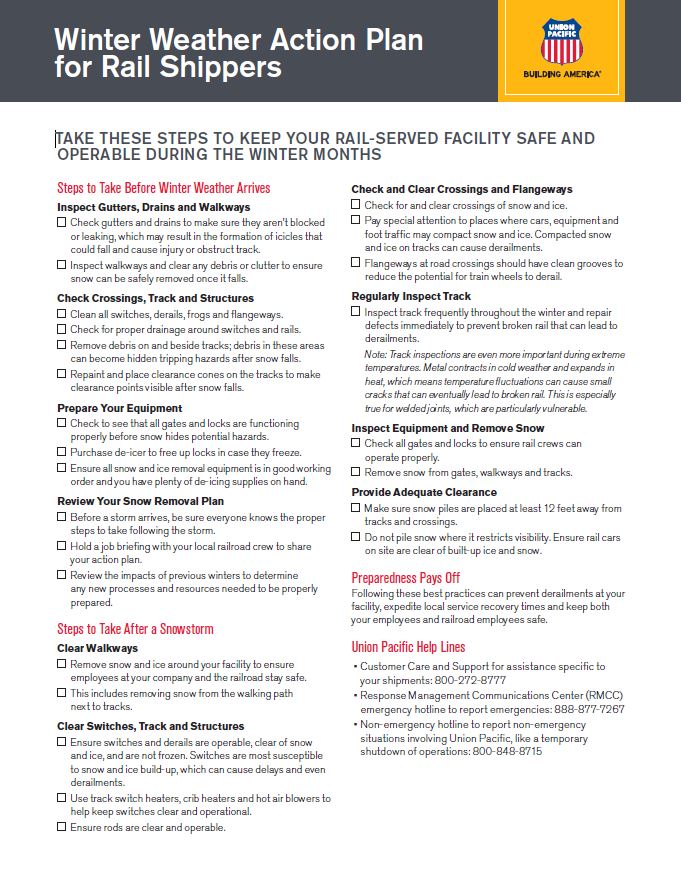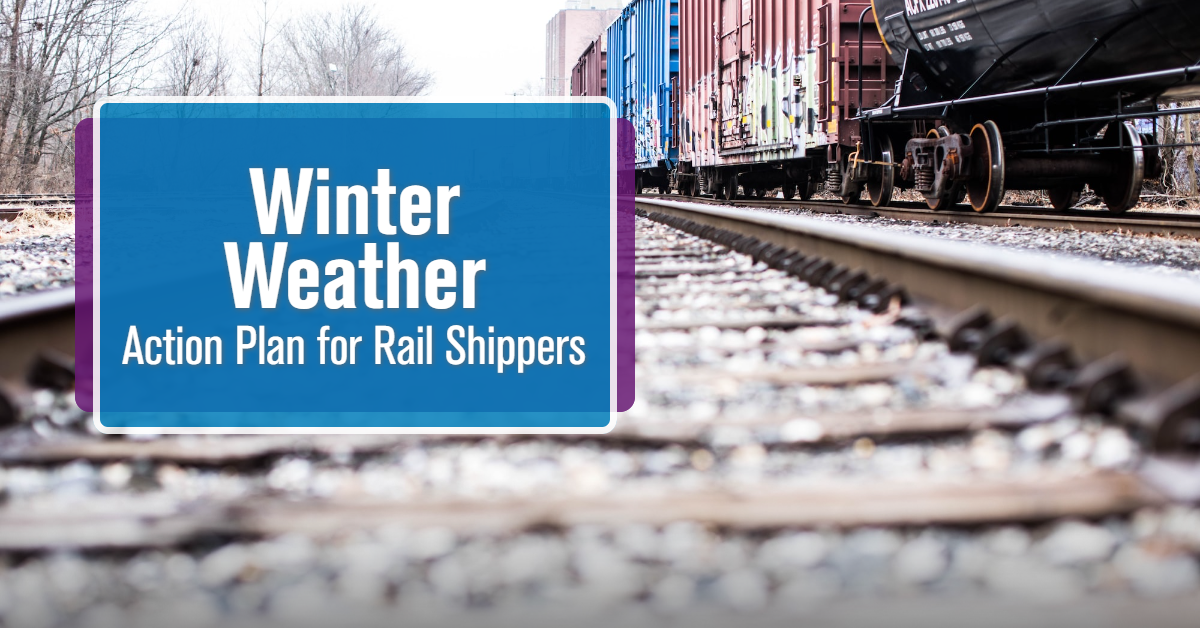Frigid temperatures, snow, and ice can be a threat to both employee safety and your supply chain. If your rail-served facility encounters inclement winter weather, failing to follow an action plan can lead to injuries, prevent rail service, and even cause derailments.
What should be included in your winter weather action plan? Members of Union Pacific’s train operations team recommend following these steps before and after a storm.
Steps to Take Before Winter Weather Arrives
- Check gutters and drains to make sure they aren’t blocked or leaking, which may result in the formation of icicles that could fall and cause injury or obstruct track.
- Inspect walkways and clear any debris or clutter to ensure snow can be safely removed once it falls.
Check Crossings, Track and Structures
- Clean all switches, derails, frogs and flangeways.
- Check for proper drainage around switches and rails.
- Remove debris on and beside tracks; debris in these areas can become hidden tripping hazards after snow falls.
- Repaint and place clearance cones on the tracks to make clearance points visible after snow falls.
Prepare Your Equipment
- Check to see that all gates and locks are functioning properly before snow hides potential hazards.
- Purchase de-icer to free up locks in case they freeze.
- Ensure all snow and ice removal equipment is in good working order and you have plenty of de-icing supplies on hand.
Review Your Snow Removal Plan
- Before a storm arrives, be sure everyone knows the proper steps to take following the storm.
- Hold a job briefing with your local railroad crew to share your action plan.
- Review the impacts of previous winters to determine any new processes and resources needed to be properly prepared.
Steps to Take After a Snowstorm
Clear Walkway
- Remove snow and ice around your facility to ensure employees at your company and the railroad stay safe.
- This includes removing snow from the walking path next to tracks.
Clear Switches, Track and Structures
- Ensure switches and derails are operable, clear of snow and ice, and are not frozen. Switches are most susceptible to snow and ice build-up, which can cause delays and even derailments.
- Use track switch heaters, crib heaters and hot air blowers to help keep switches clear and operational.
- Ensure rods are clear and operable.
Check and Clear Crossings and Flangeways
- Check for and clear crossings of snow and ice.
- Pay special attention to places where cars, equipment and foot traffic may compact snow and ice. Compacted snow and ice on tracks can cause derailments.
- Flangeways at road crossings should have clean grooves to reduce the potential for train wheels to derail.
Regularly Inspect Track
- Inspect track frequently throughout the winter and repair defects immediately to prevent broken rail that can lead to derailments.
- Note: Track inspections are even more important during extreme temperatures. Metal contracts in cold weather and expands in heat, which means temperature fluctuations can cause small cracks that can eventually lead to broken rail. This is especially true for welded joints, which are particularly vulnerable.
Inspect Equipment and Remove Snow
- Check all gates and locks to ensure rail crews can operate properly.
- Remove snow from gates, walkways and tracks.
Provide Adequate Clearance
- Make sure snow piles are placed at least 12 feet away from tracks and crossings.
- Do not pile snow where it restricts visibility. Ensure rail cars on site are clear of built-up ice and snow.
Download the Checklist

Don't miss a step! Download a printer-friendly checklist you can print and use at your facility.
Preparedness Pays Off
Following these best practices can prevent derailments at your facility, expedite local service recovery times and keep both your employees and railroad employees safe.
Additional Resources
Union Pacific Railroad offers its customers the following additional resources to aid in maintaining safe operations throughout the winter.
- Best Practices for Winter Operations at Customer Facilities, which includes more detailed information and illustrative photos related to:
- Snow removal on tracks, flangeways and switches
- Mitigating compacting issues at road and truck crossings
- Proper cleaning of industry switches
- Preventative maintenance to reduce derailment risks
- Customer Care and Support for assistance specific to your shipments: 800-272-8777
- Response Management Communications Center (RMCC) emergency hotline to report emergencies: 888-877-7267
- Non-emergency hotline to report non-emergency situations involving Union Pacific, like a temporary shutdown of operations: 800-848-8715
Learn More
To learn more about how railroads prepare for and respond to winter weather, check out the AAR’s Winter Weather Fact Sheet.
If you’re interested in getting a rail shipping quote, answer a few questions and an expert will be in touch.
Related Articles
- How to Prepare for and Recover from Hurricanes
- How to Prevent Train Derailments on Privately Owned Tracks
- Reefer Best Practices: How to Maintain Temperature and Save Fuel
- How to Clean and Inspect Rail Cars
- How to Use Carbon Calculators to Reduce Transportation Emissions
- Top Podcasts on Supply Chain Management, Freight Shipping & Logistics
- How to Load a Rail Car for Safe Freight Shipping









